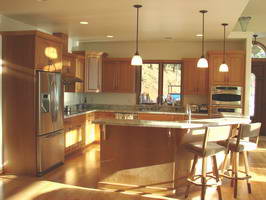Digital Timer Switch Electrical Wiring Instructions
 '; ';
|
Wiring a Timer Switch for Lighting: Requires four wires for the connections to the time switch. © By: Dave Rongey |
Requirements for Most Digital Timer Switches
Electrical Question: I just bought a Pass & Seymour RT1W Digital Timer switch to replace my simple single-pole switch.
- My problem is that the installation instructions diagram doesn’t match my simple 1975 Constructed home, switch-box configuration which is one wire set – white, black, unshielded ground connected to nothing in the box.
- My New Switch comes with Four Wires:
- White (labeled Neutral)
- Black (labeled HOT, power from circuit box)
- Red (labeled LOAD, power to lamp or fan)
- Green (labeled GROUND)
The ground is easy, but do I connect the other THREE(White, Black, and Red) RT1 switch wires to the TWO (Black & White) I have left in my old switch box?
Background: Ron, a Homeowner from Newberg, OR.
Additional Comments: I’m anxious to see how this site works out. If it is what it seems to be … this is really awesome !
Dave’s Reply:
Thanks for your electrical wiring question Ron.
How to Wire a Timer Switch for Lighting
- Ron, the digital time switch that you have requires a separate neutral wire.
- Your wiring configuration will not work with this timer unless there is a neutral wire in the switch box.
- As described above, the wiring will require four wires for the connections to the time switch.
I have provided the following that lead to fully detailed information on this website that will assist you with your Digital Timer Switch Project
- Light Switch Wiring
- Electrical Wire for the Home
- This link is helpful as a Homeowner
- Make sure not to miss these Resources for: Wiring Diagrams
Wiring Diagrams
The following may also be helpful for you:
|
|
Be Careful and Be Safe - Never Work on Energized Circuits!
Consult your Local Building Department about Permits and Inspections for all Electric Wiring Projects.
More articles about 24 Hour Time Switch, Lighting and Home Electrical Wiring: |
|
| « Previous | Next » |
Understanding Switched Outlet Wiring |
Power for Three Way Switches |














